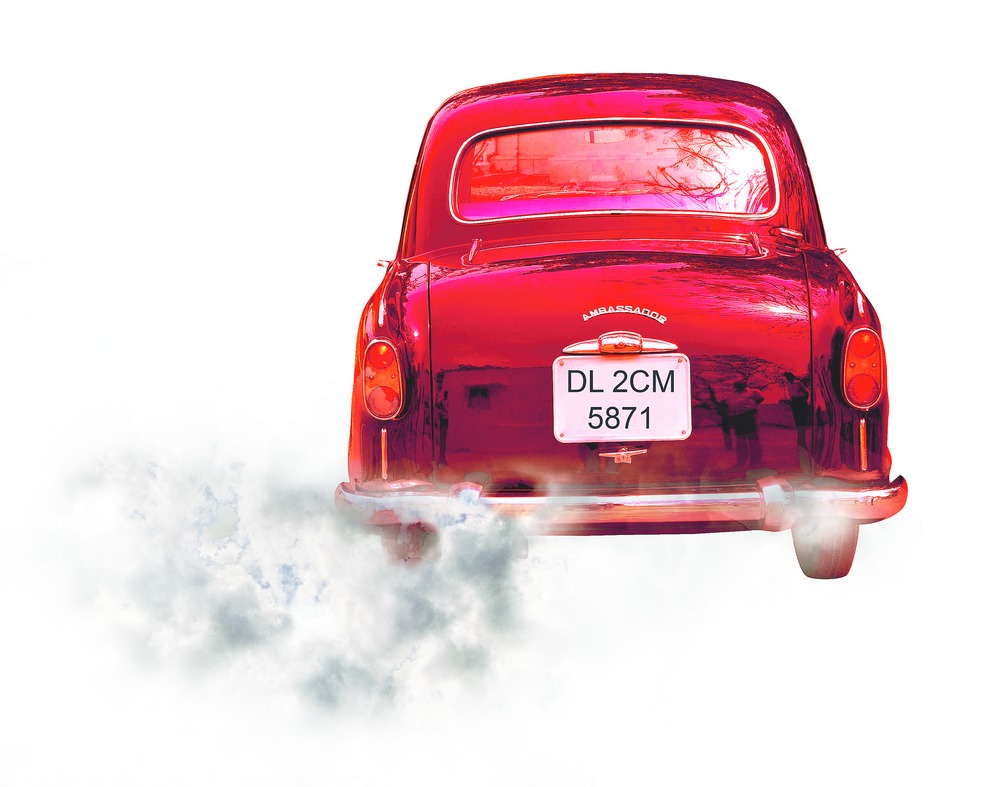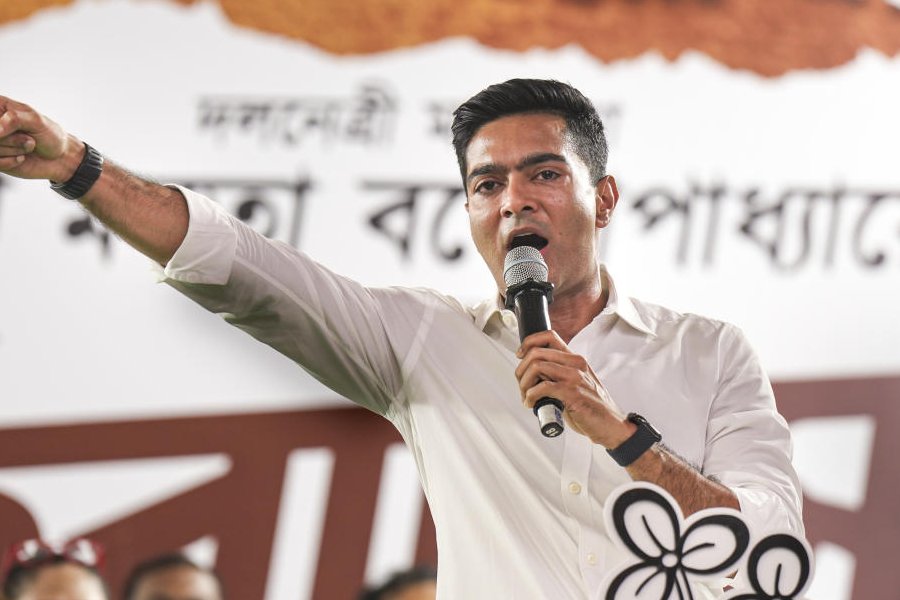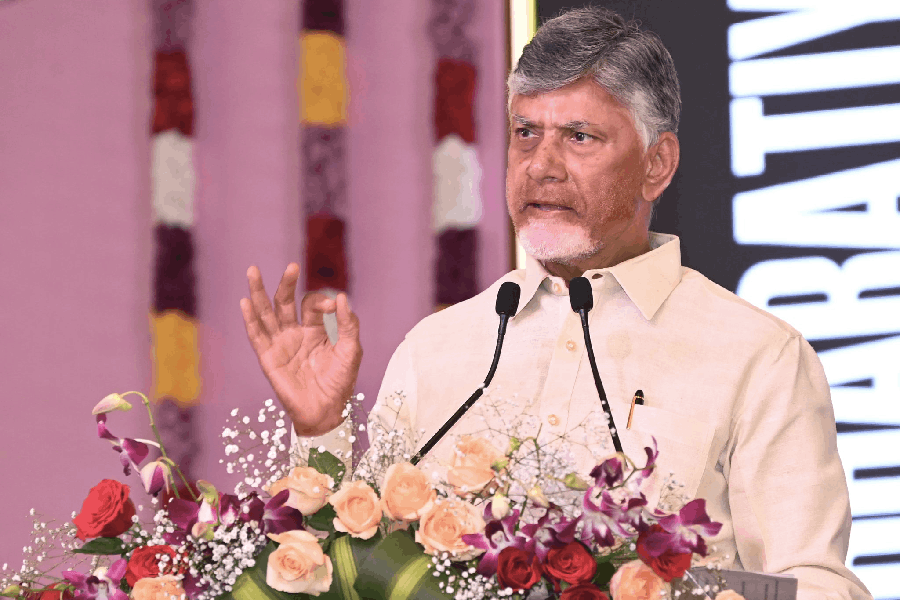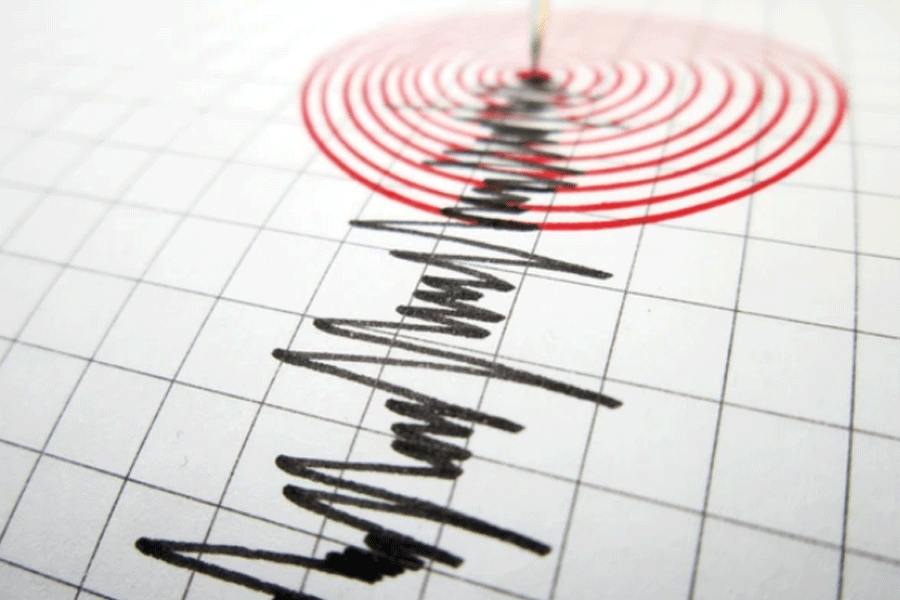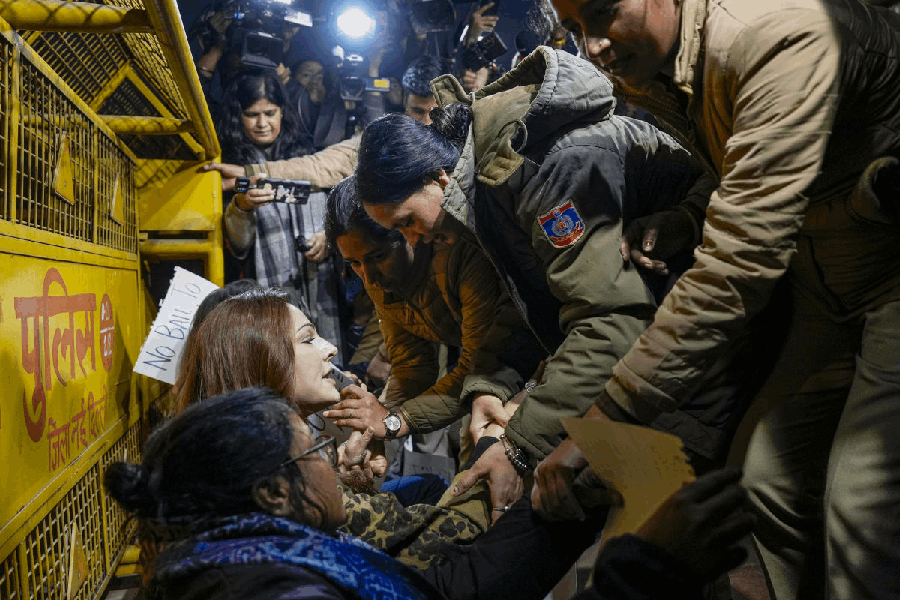
Living in Delhi, its high court said last week, was like being in a gas chamber. The court wasn't very wrong. India's capital has never been this foul. Thick smog surrounds the city, as traffic snarls tie it up in a noisy and smoky gridlock. And the air is so toxic that legislators are being forced to look at ways to clean it.
All eyes are on the city, which has just unfurled a new method of dealing with traffic congestion and the smog. For a fortnight from January 1, 2016, cars with even and odd number plates will ply the roads on alternate days. If it works, it may well be followed in other cities.
Indeed, the other cities are in need of urgent measures too. During peak hours in Bangalore, commuters are stranded for hours on the road, often missing flights and trains in the bargain. The traffic police estimates that the average speed on many city roads during the morning and evening rush hours is around 15 kilometres an hour.
And while Calcutta may be the city with the lowest vehicle density among 20 Indian cities, traffic and air pollution are serious problems. Though private vehicles - two-wheelers and cars put together - account for only 12 per cent of road trips in the city, these personal vehicles occupy more than 50 per cent of the road space.
Planners point out that Calcutta is not going to be long on the list of cities with low vehicle density either. In 1998, 1.8 per cent of households had cars; in 2008, this went up to 11 per cent. A 2011 study carried out by the New Delhi-based non-government organisation, Centre for Science and Environment (CSE), stated that the average peak hour traffic speed on 72 per cent of the roads in Calcutta was less than 20km an hour.
Across India, many Indian cities are now getting gridlocked for there is just not enough space for the vehicles that are being added to the existing numbers of fleet every day. "Increased supply, easy loans and an exploding middle-class population are leading to a situation where more and more people are buying personal vehicles," says Sudakshina Gupta, associate professor at the University of Calcutta, who specialises in transport economics.
Of course, nowhere in the country is the situation as bad as it is in Delhi.
"The problem of traffic congestion is very bad in Delhi, though I have seen worse in cities such as Lagos, Nairobi and Beijing," says Om Prakash Agarwal, a former bureaucrat with the Union ministry of urban development who holds a PhD in urban transport. "More damaging is the air quality in Delhi," he says.
That Delhi and Beijing have dangerous levels of air pollution has attracted national and international headlines - forcing governments to take steps. The government has also come under fire from the judiciary and the National Green Tribunal. Several pronouncements by different courts in recent times have urged the authorities to find means to clean the toxic air that makes children and the elderly vulnerable to deadly respiratory ailments. In fact, studies carried out by the Central Pollution Control Board, New Delhi, and the Calcutta-based Chittaranjan National Cancer Institute have shown that every third child in Delhi has impaired lungs.
For the record, it's not that governments have been sitting idle, watching the air go from bad to worse. In 2001, Delhi, which was then the fourth most polluted city in the world, was forced by the Supreme Court of India to introduce the cleaner, compressed natural gas (CNG) as fuel for public transport vehicles, which were till then running on the highly polluting diesel. The measure, introduced despite widespread protests by the all-powerful automobile industry, reduced air pollution in the capital by a whopping 72 per cent by 2008.
But the advantage was reversed in the subsequent years, as more and more private vehicles were added to the already humungous number of cars in the city. Today, private cars and two-wheelers account for more than 95 per cent of the 90 lakh vehicles registered in the capital, according to the 2014-15 Economic Survey of the Delhi government. And the city adds 1,400 new vehicles to its roads every day.

The odd-and-even licence plate move is being introduced to combat the growing traffic - and ensuing health - menace. Last week, the government of Delhi announced a slew of measures to improve the city's air quality. The boldest - or most controversial - among them was the move to introduce the odd-and-even formula for private cars. The rule will be relaxed on Sundays, and for women and for people with special needs.
"Desperate times need desperate measures," says Anumita Roychowdhury, deputy director-general, CSE, who has campaigned for reducing air pollution in Delhi and other cities for nearly three decades.
But this is just one step, she adds. "Unless it is followed up with a stringent parking policy, tough registration and taxation measures, the purpose will be defeated," she holds. And without improving the public transport system in the city - which should tempt car users to take public buses or trains - such measures would be futile.
Not everybody is in favour of the move, applicable from 8am to 8pm. A large number of people who need to move around the city as part of their occupation - such as marketing executives, sales personnel and reporters - have expressed concern on various social media forums that the implementation of the rule would seriously impact their work. Second, such measures work only if the public transport is efficient and there is a culture of pooling cars.
To top it, the enforcement of the rule is going to be a daunting task. Given the current strength of the traffic police in Delhi, it would not be possible to issue challans to all errant drivers, says a senior Delhi Police (traffic) official. "We would face a manpower shortage," he says. And the fine has to be hefty enough to deter people from taking their cars out when they are not supposed to.
The automobile industry, not surprisingly, thinks that private car owners are being unduly targeted. "I don't think it is fair to single out cars for air pollution. Of the overall vehicular emissions, cars contribute only around 10 per cent, while two-wheelers contribute around 40 per cent and the rest is by public transport and trucks. If so, why single out cars and car owners," Sugato Sen, director general of auto industry body Siam, said in a statement last week.
The CSE, on the other hand, says that cars account for 22 per cent of vehicle pollution in the capital. Two-wheelers and trucks contribute 32 per cent and 28 per cent, respectively.
Another problem with the odd-and-even move is that it may prompt people to buy another vehicle so that they have both an even and an odd number plate.
This happened in Mexico City which had to discontinue the initiative two and a half years after it was implemented in 1989, points out S. Velmurugan, a scientist specialising in traffic engineering and safety at the Delhi-based Central Road Research Institute.
As the Mexico government didn't restrict vehicle ownership, those who could afford to do so bought a second car which was usually old and had inferior technology and hence was more polluting. This actually defeated the original purpose of reducing pollution," Velmurugan says.
If this happens in Delhi, the city will come to a complete standstill. Already it has 158 cars for 1,000 people - Singapore has 60 and Hong Kong 25.
The Delhi government move will ease traffic congestion, experts believe, because public transport will move more easily. "Currently less than 20 per cent of (car and two-wheeler) users occupy 80 per cent of the roads in Delhi," says Ashok Bhattacharjee, an architect and urban transport planner formerly with the Unified Traffic and Transportation Infrastructure (Planning & Engineering) Centre, established by the Delhi Development Authority in 2009 to ease congestion and improve mobility in Delhi.
But environmentalists hope that it will also, to some extent, bring down air pollution. A large number of vehicles being forced to stay off the road will improve the traffic situation, which will in turn help public transport services and the vehicles that are permitted to be on the road to move faster, reducing travel time and emissions. This can indirectly help reducing air pollution levels.
Many hold that there is little that the government can do to ease traffic apart from restricting cars and other related measures. With 21 per cent of land area under roads, Delhi has no scope for further increasing its road network, which is currently 33,000km long. Delhi has more road space than many other international cities compared to its total area.
Even cities which have much higher population densities than Delhi - such as Hong Kong, Paris and Tokyo - have a lower road space ratio. About 13 per cent of Tokyo has been allotted to roads, 12 per cent in Hong Kong and 11 per cent in Paris.
"Having high road space is not necessarily a good thing. It means more vehicles and more pollution," Agarwal points out. "That is why Delhi has by far the highest number of vehicles in India and more than Calcutta, Mumbai and Chennai put together," he says.
The city that is aping Delhi is the cyber capital and erstwhile Garden City, Bangalore. It has 52 lakh registered private vehicles - the highest in the country after Delhi. It has also been ramping up its road network rapidly. Today, nearly 12 per cent of its land area is under roads. Calcutta, on the other hand, has only 7 per cent area allocated for roads.
"It's a myth that wider roads will help ease traffic congestion," explains Anvita Arora, chief executive officer of iTrans Private Limited, a New Delhi-based firm that specialises in innovative transport solutions. "Widening a road would mean diminishing the space available for footpath and cycle tracks. For the comfort of a few road users, authorities are actually putting the lives of those who opt for non-motorised modes of transport like walking and cycling at danger," says Arora, who has a PhD from the Indian Institute of Technology, Delhi.
One of the long-term measures to combat traffic and pollution would be by allocating space for pedestrians and bicycle users so that people do not have to take out their cars for short trips such as when they go to neighbourhood shops or to drop a child to school, she says.
Some of these measures still exist in Calcutta, Arora and Roychowdhury point out. The city should hold on to its tradition of having wider footpaths for people to walk on and dedicated cycle lanes. Most travel trips in Calcutta are less than 5km long and can be done by walking or by non-motorised means, Roychowdhury says.
"The city has to modernise and improve its public transport system so that people are encouraged to use it and restrict the use of cars for daily trips," she adds.
Contrary to popular belief, flyovers are not the answer to gridlocked roads, the experts say. They actually create more problems. "Flyovers only move traffic congestion from one place to another. These congestions often travel like waves," says Vivek Chattopadhyay, a researcher with CSE who specialises in air pollution.
That is the reason, Arora points out, that Seoul in South Korea is breaking down flyovers.
So what then is the solution? According to Velmurugan, many cities in the world have successfully used the odd-and-even formula to reduce traffic congestion. But The Times, London, said last week: "Critics have noted that many cities, including Lagos, Athens and Beijing, have tried similar schemes with little success... A similar initiative in Paris last year was abandoned after just 24 hours."
Interestingly, some people in Bangalore are looking at it as a part solution to the problem of traffic congestion. A city foundation started by IT professionals in its technology corridor - Whitefield Rising - has plans to start the Delhi government's odd-even system voluntarily on an experimental basis. The scheme will be started in Whitefield, Sarjapur Road and Outer Ring Road, where most of the city's IT firms are located.
Residents will be asked to take out their vehicles only on the dates specified, says a Whitefield Rising volunteer. "The group will also set up car pooling points on all major roads to ensure that people can pool cars easily," he adds.
Unlike the Bangalore group, Delhi's citizens have been lukewarm to the proposal, but should embrace ways of controlling traffic, the experts hold. "The traffic volume in Delhi has increased by 3-5 per cent annually. On the roads along certain Metro rail corridors, it is slightly less at 1-2 per cent," Velumurugan says.
To boost the use of Metro - which has a wide network in Delhi now - he suggests that more focus be given to the "last mile connectivity" to and from Metro stations so that people are encouraged to use it. The Delhi Metro already covers 187 kilometres and a network of 117km length will be added to it when its third phase is completed in 2017.
Apart from the odd-and-even formula, city governments elsewhere have been using other means to reduce traffic volume. One of the most effective ways is slapping a congestion fee on cars entering central business districts which are crowded. This is in use in at least a dozen cities in world. Studies carried out in Singapore and Central London have shown that the measure is highly effectively in reducing traffic volume and increasing traffic speeds. For instance, after its implementation in London, the traffic volume came down by 21 per cent and speed went up by 10 per cent.
Researchers at the Indian Institute of Science (IISc) in Bangalore have studied the problem to see if enforcement of congestion charges can work in Indian cities. The researchers led by Ashish Verma of IISc's Centre for Infrastructure Sustainable Transportation and Urban Planning have found that by charging a nominal fee the percentage of cars and two-wheelers travelling to a congested city area can be brought down by 14 and 2.4 per cent, respectively.
"Politicians think such measures are anti-people and hence do not want to implement them as they fear this will make them unpopular. It is just the opposite. In the long run, people are going to benefit from such moves. But someone should convey this to them effectively," says Verma, whose study appeared in the journal Case Studies in Transport Policy in September this year.
Roychowdhury, however, is hopeful that the public pressure is building up in the country. "No politician can ignore it," she says.
What others do
Singapore
Area Licensing System
In 1975, Singapore introduced an Area Licensing System (ALS), centred on the concept of road pricing, to reduce congestion in the central business district. It improved the traffic speed from 26 km/hr to 35 km/hr.
Seoul
Car-free days
Seoul’s weekly No Driving Day programme is improving air quality, congestion and saving energy. A voluntary programme where people choose one day a week (Monday to Friday) as a no-driving day. Participants get discounted, free parking and car washes. So traffic volume has dropped 3.7 per cent decrease and operating speed has increased by 3 per cent. More than half a million cars participate.
London
London levies a congestion charge for about 20 sqkm around the city centre since February 2003. Vehicle traffic decreased by 21 per cent and cycling increased by 43 per cent.
Bogota
TransMilenio, a Bus Rapid Transit system, has been implemented since 2000. The system was chosen because it was cheaper than a railway system.
With TransMilenio, traffic accident fatalities have reportedly dropped by 93 per cent; there has been a 40 per cent reduction in some air pollutants and a 32 per cent drop in travel time for users.

Additional reporting by Varuna Verma in Bangalore, Sonia Sarkar in New Delhi and Moumita Chaudhuri and Abimanyu Nagarajan in Calcutta

